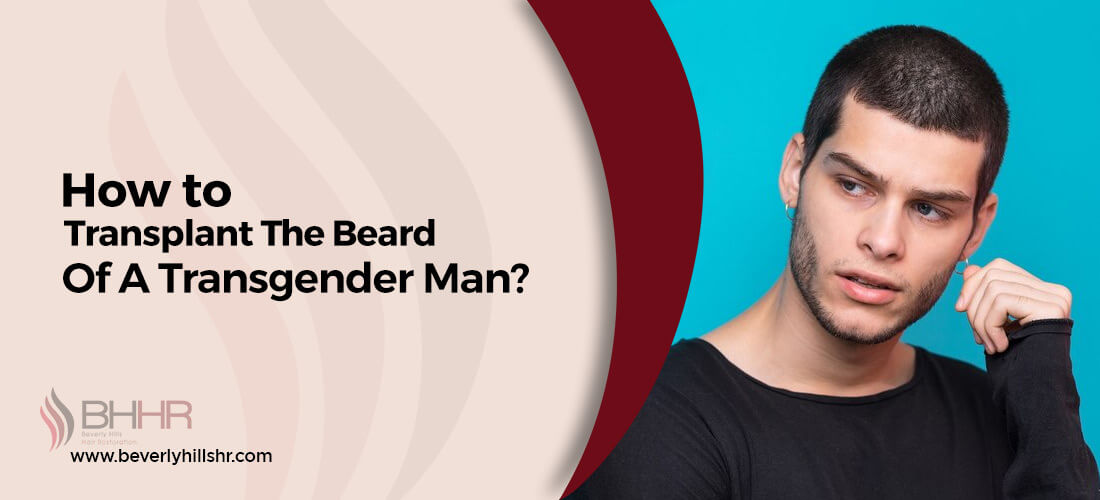How to Transplant The Beard Of A Transgender Man?
Home / Transgender Hair Transplant / How to Transplant The Beard Of A Transgender Man?
Updated On : July 18, 2024 | Category : Transgender Hair Transplant | Author: Beverly Hills Hair Restoration Team

Many people view facial hair as indicative of masculinity. One of the most common desires of trans men during transition is to begin beard growth. Unfortunately, not every cisgender or transgender person has the same level of success when trying to grow a beard. So how do transgender males get facial hair?
Transgender men can get the rugged, masculine look they want with the help of a beard hair transplant. Here is some information about the transgender facial hair transplant procedure and what trans men can expect.
What Are Facial Hairs?
Facial hair is not exclusively a male trait. Men typically have fuller, darker, and long beards and mustaches than women do because of the hormonal effects of sex on the hair. Genetic makeup can also influence how noticeable and thick one's hair is. The hair on some people's cheeks and upper lip is fine and downy, while it is thick, dark, and full on others. Puberty usually causes noticeable facial hair growth in those whose sex at birth was male.
An increase aids this hair growth with testosterone. Facial hair growth is typical, appearing first above the upper lip. Later, it moves on to the sideburns, the chin, and the cheeks. Some men even develop a beard or mustache till their necks. A person's hair follicle count is a significant factor in determining how much facial hair they will develop. Your DNA largely predetermines the number of hair follicles you have. Some men just get fewer strands than others as facial hair.
Read More: Cost And Need Of Hairline Lowering Transplant
What Influences Facial Hair Growth in FTM Patients?
Hormones and genetics typically control the growth of facial hair in FTM people. You'll likely be able to grow facial hair quickly after transitioning if you come from a family where both men and women have full and thick beards and mustaches. Some FTMs undergo hormone replacement therapy (HRT) to hasten beard development. In these people, testosterone triggers a second puberty. This stimulates the growth of new hair. Some people taking testosterone may notice an increase in facial hair, but this is not the case for everyone. Facial hair growth can occur in some people without hormones, so keep that in mind.
Beard Transplant Procedures For Transgender Man
When performing a beard transplant, a hair restoration surgeon may choose to use either the Follicular Unit Transplantation or the Follicular Unit Extraction hair transplant techniques. The number of follicles required to achieve the patient's goals is a primary consideration in determining the procedure they will perform.
1. Follicular Unit Transplantation (FUT)
Follicular Unit Transplantation (FUT) is called the "strip" method or follicular unit grafting (FUG). According to experts, when Fut Hair Transplant is used, a surgeon will cut out a strip of scalp from the back or sides of the patient's head. The width of the strip is typically between 1 and 1.5 cm. The total size is determined by the number of graft follicles required by the transplant surgeon. The surgeon will use stitches to close the incision made when the strip is removed.
A small scar will form at the incision site after it heals. Next, the surgeon will carefully implant the harvested follicles into the patient's facial skin, considering the patient's desired level of beard restoration. The bristles should be arranged in a manner that is as close to the pattern of the user's actual facial hair.
2. Follicular Unit Extraction (FUE)
FUE Hair Transplant is still used occasionally, but it has been largely replaced by follicular unit harvesting, a more modern and sophisticated technique. However, in FUE, only a single hair follicle is removed, unlike the thousands removed in FUT. For FUE procedures, the plastic surgeon will use a tiny drill called a micro punch to remove hair follicles. The instrument punctures the skin near the follicle and gently pulls the strand out while preserving it.
Compared to FUT hair transplant, FUE may require more attention to detail because each follicle group must be removed separately. The good news is that this procedure results in minimal scarring, making it a viable option for those who prefer short hairstyles. Once the follicles have been extracted, the FUE procedure is identical to the FUT procedure. The surgeon will then transplant the hairs to the areas of the patient's face where a beard is desired. Now that you know what facial hair is and what influences its growth, plus the transplant procedures, let’s answer the question: how do transgender males get facial hair?
Source of the Donor Hair in Beard Transplants
Beard transplants require hair harvested directly from the recipient's body, which is a significant consideration. If the donor is not a sibling or known acquaintance, the hair transplant transgender recipient must take drugs to suppress the immune system. There are many reasons why your doctor would prefer harvesting hair follicles from the back and sides of the head. Hair growing in these areas is typically immune to the hormone that causes male pattern baldness. As a rule, those regions also sport voluminous amounts of hair.
However, if you don't have much hair on the back or sides of your head, our surgeons can discuss alternative donor sites, such as arms and legs. One factor that could determine whether or not you are a good candidate for the procedure is the quantity of hair you have.
What to Expect During a Transgender-Beard Transplant Procedure?
Discuss your desired beard and mustache style with our surgeon, Dr. John Kahen, before undergoing a beard transplant. The surgeon will draw a pattern on your face to help them place the donor follicles correctly. To complete your new beard, you and your surgeon may also discuss which donor hairs will work best. Your surgeon may recommend using hair from your scalp or other body parts, both of which will depend on the texture and color of your natural facial hair.
Once you've decided on a style and donor area, the hair transplant surgeon can begin taking hair for the new beard. The donor site will be numbed with a local anesthetic, and the patient may be given a sedative orally. After the follicles have been harvested, the surgeon will prepare them for implantation and place them in the appropriate locations on the patient's face. The beard transplant procedure can last for two to eight hours.
Closing Remarks
A transgender facial hair transplant can give you the masculine appearance you have always wanted. Growing facial hair will boost your confidence and help to accept your desired gender or sex status. The surgeon will likely use HRT to enable transgender people to grow facial hair. And as expected, the doctor may choose FUE or FUT to achieve the desired look. If you are a transgender man needing a professional beard hair transplant, make an appointment with Beverly Hills Hair Restoration.
For any questions regarding our transgender beard hair transplant procedure, you can contact us at 310.289.0901 or Schedule a free hair transplant consultation.
Here are a few more topics that you shouldn’t miss:
Hair Transplant For African Americans: The Ultimate Guide To Hair Loss
Like this post? Don’t forget to share
